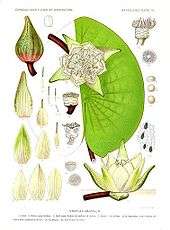Henry Shoemaker Conard
| Henry S. Conard | |
|---|---|
| Born |
September 12, 1874 Philadelphia, Pennsylvania |
| Died |
October 7, 1971 (aged 97) Haines City, Florida |
| Residence | United States |
| Nationality |
|
| Fields | Botany, bryology |
| Institutions | Grinnell College (1906–1955) |
| Alma mater | Haverford College (B.S. 1894, M.S. 1895) and University of Pennsylvania (Ph.D. 1901) |
| Notable awards | Eminent Ecologist Award from the Ecological Society of America (1954)[1] |
Henry Shoemaker Conard (1874 - 1971) was a leading authority on bryophytes and water lilies, as well as an early advocate of environmental preservation. From 1906 to 1955, Professor Conard worked at Grinnell College in Grinnell, Iowa.[2] In 1954, he became the first to receive the Eminent Ecologist Award from the Ecological Society of America, an award that has continued annually ever since.
In 1969, Grinnell acquired a 365-acre (1.48 km2) plot of cropland and established the Conard Environmental Research Area, in recognition of the legacy of the longtime professor.[3]
Early years
Conard was born September 12, 1874 in Philadelphia, Pennsylvania, to Thomas Pennington Conard and Rebecca Savery Baldwin Conard. He attended Friends' Select School in Philadelphia from 1881 to 1888. He entered Westtown Friends' Boarding School in Westtown, Pennsylvania in 1889 and graduated as valedictorian in 1892. He then enrolled at Haverford College, where he earned a B.S. in 1895 and an M.A. in 1895. While at Haverford, he was inducted into Phi Beta Kappa.[2]
Career
After a short time teaching science in Westtown, he entered the University of Pennsylvania as a Harrison Fellow in Biology in 1899, completing his Ph.D. in 1901 and joining Sigma Xi. After receiving his doctorate, Conard taught botany at the university from 1901 to 1905. From 1905 to 1906, he was a Johnston Scholar at Johns Hopkins University.[2]
In 1906, Conard left Johns Hopkins to take a professorship in botany at Grinnell College. During his tenure at Grinnell, Professor Conard served as chair of the department of botany and, starting in 1935, as Chairman of the Faculty. He received emeritus faculty status in 1944. After his retirement, Professor Conard continued to be academically active, notably curating the bryophyte collections at the University of Iowa and running the Moss Clinic at the Iowa Lakeside Laboratory.[4]

Selected publications
- The Waterlilies: A Monograph of the Genus Nymphaea (1905), Washington: Carnegie Institution of Washington.
- The Structure and Life-history of Hay-scented Fern (1908), Washington: Carnegie Institution of Washington.
- How to Know the Mosses and Liverworts (1979), Dubuque, Iowa: W.C. Brown
Personal life
Conard and his wife moved in 1955 to Florida, where they resided until his death on October 7, 1971 in Haines City, Florida.[6][7]
Notes
- ↑ Ecological Society of America. "ESA History > Awards". Accessed April 29, 2008
- 1 2 3 Welch and LeBlanc 1972, p. 558
- ↑ Grinnell College, Department of Biology. "CERA History". Accessed April 29, 2008.
- ↑ Welch and LeBlanc 1972, p. 559
- ↑ IPNI. Conard.
- ↑ "Dr. Conrad Dies, Leading Botanist". Al and Dorothy Pinder. The Grinnell Herald-Register. 11 October 1971. Retrieved 21 January 2016.
- ↑ "Henry S. Conard". Grinnell College. Grinnell College. Retrieved 21 January 2016.
References
| Wikimedia Commons has media related to Henry S. Conard. |
- Welch, Winona H. and Fabius LeBlanc. (1972). "Henry S. Conard". The Bryologist, 75(4): 558-565. JSTOR stable URL
- Conard biography and text of Nyphaeae, The Waterlilies. The site also includes a 1944 photo of Professor Conard.